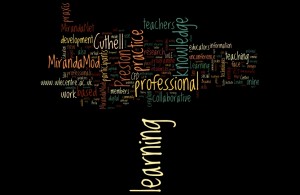From practice to praxis
- Learning
- Beyond Collaborative Learning
- From practice to praxis
- ICT CPD Landscape Review
- ICT delusions: Plus Ça Change?
- Is teaching a technology, or is it more than that?
- Learning in Liminal Spaces
- Learning in Liminality
- MirandaMods
- Online forums as resources for teacher professional development
- A Learning Community
- The Role of Web-based Communities in Teacher Professional Development
- A City Learning Centre
Summary
This project builds on previous work undertaken by MirandaNet to explore the possibilities of teacher continuing professional development (CPD) in a time of increased workload, budget constraints and the need for professional change. The importance of work based learning, and the emerging informal processes by which theory can be transformed into practice by education practitioners themselves, (‘praxis’: Freire, 1970) has become more important as teachers respond to the twin drivers of personalised learning and technology integration. Traditional CPD offerings are not positioned to respond to such demands: one-day general courses struggle to provide the transformational elements that today’s education professionals need. (Daly, Pachler & Pelletier, 2009a; 2009b; Pachler, Preston, Cuthell, Allen, 2010)
The Becta-funded 2009-10 project explored mobile learning from a range of perspectives in eight MirandaMods . These involved simultaneous virtual and face-to-face debates between professional educators in a global context. Resources were then made available to the wider community through reports, video recordings and interactive concept maps. Multidimensional concept mapping was developed as the data collection method because this medium stimulates the creation and dissemination of collaborative knowledge within the profession (Preston 2009a, 2009b).
The 2009-10 project collected research data about the relationship between work-based learning and praxis; developed new knowledge and practice on concept mapping methodology; disseminated professional work-based practice in mobile learning to an emerging global community; provided online resources for practitioners; developed strategies for practitioners to implement change and built an online support community. The project was informed by the work of Pachler and Cook (2009), whose approach moved professional development from the model referred to as ‘from theory to practice’ to one in which different forms of knowledge are “… contextualised and ‘recontextualised’ as people move between different sites of learning in colleges and workplaces. (It) … encapsulates the ways in which learners mediate between these contexts and as a result personalise their learning, and develop a professional and/or vocational identity.” (Pachler & Cook, 2009)
This project explored such mediation between the contexts of a face-to-face seminar together with the virtual collaborative affordances of FlashMeeting, an interactive collaborative concept map, a broadcast video stream through TwitCam and blip.tv and Twitter streams. The project developed the ways in which communities of practice create knowledge collaboratively and, more importantly, looked at the ways in which such knowledge can be applied both within, and between, classrooms – snd its implementation in teaching and learning.
The project further developed the liminal spaces where collaborative knowledge creation is now taking place. Its findings are intended to facilitate bridging the gap between the creation of professional theory and its implementation in teaching and learning – the development of “a professional and/or vocational identity.” (Pachler & Cook)
The term “liminal space” is a term drawn from anthropology that describes a rite of passage, in which a person moves from one state to another. Turner (1982) appropriates the concept to apply to drama, whereas Meyer and Land (2005) see it in terms of individuals’ ICT use. The anthropological view sees the liminal state as involving a period of time in which an individual may oscillate between old and new states, involve a range of emotions including anticipation, difficulty and anxiety, and at times require the mimicry of the new state until it becomes ‘natural’. ICT users are transformed in the liminal space by acquiring new knowledge, a new status and a new identity in the community.
This is of critical importance if ICT CPD is to be successful.
